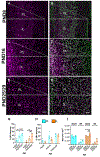Forebrain expression of serine racemase during postnatal development
- PMID: 33592203
- PMCID: PMC8012237
- DOI: 10.1016/j.neuint.2021.104990
Forebrain expression of serine racemase during postnatal development
Abstract
N-methyl-D-aspartate receptors (NMDARs) are important for synaptogenesis, synaptic maturation and refinement during the early postnatal weeks after birth. Defective synapse formation or refinement underlie cognitive and emotional abnormalities in various neurodevelopmental disorders (NDDs), including schizophrenia (Sz) and autism spectrum disorder (ASD). Serine racemase (SR) is a neuronal enzyme that produces D-serine, a co-agonist required for full NMDAR activation. NMDAR hypofunction as a result of genetic SR elimination and reduced synaptic availability of D-serine reduces neuronal dendritic arborization and spine density. In adult mouse brain, the expression of SR parallels that of NMDARs across forebrain regions including the striatum, amygdala, hippocampus, and medial prefrontal cortex (mPFC). However, there have yet to be studies providing a detailed characterization of the spatial and temporal expression of SR during early periods of synaptogenesis. Here, we examined the postnatal expression of SR in cortical and subcortical brain regions important for learning, memory and emotional regulation, during the first four weeks after birth. Using dual-antigen immunofluorescence, we demonstrate that the number of SR+ neurons steadily increases with postnatal age across the mPFC, amygdala, hippocampus and striatum. We also identified differences in the rate of SR protein induction both across and within brain regions. Analyzing existing human post-mortem brain in situ data, there was a similar developmental mRNA expression profile of SRR and GRIN1 (GluN1 subunit) from infancy through the first decade of life. Our findings further support a developmental role for D-serine mediated NMDAR activation regulating synaptogenesis and neural circuit refinement, which has important implications for the pathophysiology of Sz and other NDDs.
Keywords: D-serine; GRIN1; N-methyl-D-aspartate receptor (NMDAR); Schizophrenia; Serine racemase; Synaptogenesis.
Copyright © 2021 Elsevier Ltd. All rights reserved.
Conflict of interest statement
Conflicts of interest
DTB served as a consultant for LifeSci Capital and received research support from Takeda Pharmaceuticals. All other authors report no biomedical financial interests or potential conflicts of interest.
Figures





Similar articles
-
Cross species review of the physiological role of D-serine in translationally relevant behaviors.Amino Acids. 2023 Nov;55(11):1501-1517. doi: 10.1007/s00726-023-03338-6. Epub 2023 Oct 13. Amino Acids. 2023. PMID: 37833512 Free PMC article. Review.
-
Postsynaptic Serine Racemase Regulates NMDA Receptor Function.J Neurosci. 2020 Dec 9;40(50):9564-9575. doi: 10.1523/JNEUROSCI.1525-20.2020. Epub 2020 Nov 6. J Neurosci. 2020. PMID: 33158959 Free PMC article.
-
Serine racemase deletion disrupts memory for order and alters cortical dendritic morphology.Genes Brain Behav. 2011 Mar;10(2):210-22. doi: 10.1111/j.1601-183X.2010.00656.x. Epub 2010 Nov 2. Genes Brain Behav. 2011. PMID: 21029376 Free PMC article.
-
Cortical synaptic NMDA receptor deficits in α7 nicotinic acetylcholine receptor gene deletion models: implications for neuropsychiatric diseases.Neurobiol Dis. 2014 Mar;63:129-40. doi: 10.1016/j.nbd.2013.11.021. Epub 2013 Dec 8. Neurobiol Dis. 2014. PMID: 24326163 Free PMC article.
-
The Role of Serine Racemase in the Pathophysiology of Brain Disorders.Adv Pharmacol. 2018;82:35-56. doi: 10.1016/bs.apha.2017.10.002. Epub 2017 Nov 29. Adv Pharmacol. 2018. PMID: 29413527 Free PMC article. Review.
Cited by
-
Serine racemase deletion alters adolescent social behavior and whole-brain cFos activation.Front Psychiatry. 2024 Jun 24;15:1365231. doi: 10.3389/fpsyt.2024.1365231. eCollection 2024. Front Psychiatry. 2024. PMID: 38979499 Free PMC article.
-
d-Serine Increases Release of Acetylcholine in Rat Submandibular Glands.Biology (Basel). 2023 Sep 11;12(9):1227. doi: 10.3390/biology12091227. Biology (Basel). 2023. PMID: 37759626 Free PMC article.
-
Reduced d-serine levels drive enhanced non-ionotropic NMDA receptor signaling and destabilization of dendritic spines in a mouse model for studying schizophrenia.Neurobiol Dis. 2022 Aug;170:105772. doi: 10.1016/j.nbd.2022.105772. Epub 2022 May 20. Neurobiol Dis. 2022. PMID: 35605760 Free PMC article.
-
d-Serine Inhibits Non-ionotropic NMDA Receptor Signaling.J Neurosci. 2024 Aug 7;44(32):e0140242024. doi: 10.1523/JNEUROSCI.0140-24.2024. J Neurosci. 2024. PMID: 38942470 Free PMC article.
-
Cross species review of the physiological role of D-serine in translationally relevant behaviors.Amino Acids. 2023 Nov;55(11):1501-1517. doi: 10.1007/s00726-023-03338-6. Epub 2023 Oct 13. Amino Acids. 2023. PMID: 37833512 Free PMC article. Review.
References
-
- Balleine BW, Liljeholm M, Ostlund SB, 2009. The integrative function of the basal ganglia in instrumental conditioning. Behav Brain Res 199, 43–52. - PubMed
Publication types
MeSH terms
Substances
Grants and funding
LinkOut - more resources
Full Text Sources
Other Literature Sources
Research Materials

